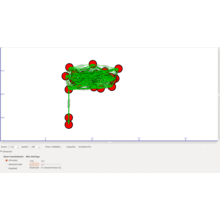Tag Archive: 'ns3 example'
Ethernet has become the primary network protocol used due to its undeniable advantages such as low cost, high speeds or ease of management. Being a best effort protocol, the IEEE Data Center Bridging Task Group developed a series of Layer 2 enhancements including Quantized Congestion Notification (QCN) and enabled a loss less environment. In this paper we […]
Software Defined Networking (SDN) and Named Data Networking (NDN) are two topics which have received lots of attention in the networking research community in recent years. While both have emerged independently from each other we believe that their core features can be well aligned to each other. Hence combining both may hold potential benefits for network operators. In this paper we investigate the advantage […]
OFDM technique has wide usage in modern communication systems, it can offer efficient use of frequency spectrum and high service quality for users. In literature, there are some software definedradio implementations of OFDM technique. OFDMA technique that can deliver advantages of OFDM technique to multi-user and dynamic based systems is more important for modern communications systems. In […]
We experimental validated a Hierarchical Controlled Software Defined Networks Architecture for IP over Optical Transport Network. OpenDayLight is chosen as the basic SDN controller for our extensions. Our implementation includes interaction between controllers and three function module extensions inside OpenDayLight to control the optical network. An successful experimental of end to end dynamic connection establishment is […]
Software defined networks (SDN) provide flexibility for developing new network protocols and policies in real networks. The SDN controller translates network policies into specific rules in the flow tables (which are usually implemented using ternary content addressable memory (TCAM)) of each networkswitch. However, due to the limitation of TCAM (e.g., high power consumption and high heat generation), flow tables cannot scale beyond a few […]
Smart cities are becoming more and more popular primarily due to increasing TIC innovations and administrative efforts from city councils to better connect citizens through stateof- the-art technology. Currently a smart city is no longer focused just on offering administrative services, but on providing useful and pervasive information to citizens and serving as basic data […]
Vital signs obtained from people playing various types of sports can be exploited not only for diagnosing their physical conditions but also for learning the best practice to be followed to enhance their sporting abilities and skills. In this paper, focusing on a framework to collect vital data from a human group consisting of a […]
Flash flood is a natural disaster that causes great losses; it happens mostly in rural areas. Heavy rainfall is gathered into the main river on watershed areas. Lots of water comes into the river. This causes a great volume of water flows down to the lower area of watershed. The great volume of water rapidly […]
This paper lays the ground work for assistive navigation using wearable sensors and social sensors to foster situational awareness for the blind. Our system acquires social media messages to gauge the relevant aspects of an event and to create alerts. We propose social semantics that captures the parameters required for querying and reasoning an event-of-interest, such as what, where, who, when, severity, and action […]
Molecular communication holds the promise to enable communication between nanomachines with a view to increasing their functionalities and opening up new possible applications. Due to some of the biological properties, bacteria have been proposed as a possible information carrier for molecular communication, and the corresponding communication networks are known as bacterial nanonetworks. The biological properties include the […]

 Click Here to watch our latest output video using NS3 simulator
Click Here to watch our latest output video using NS3 simulator  Click Here to watch our latest projects screenshots using NS3 simulator
Click Here to watch our latest projects screenshots using NS3 simulator